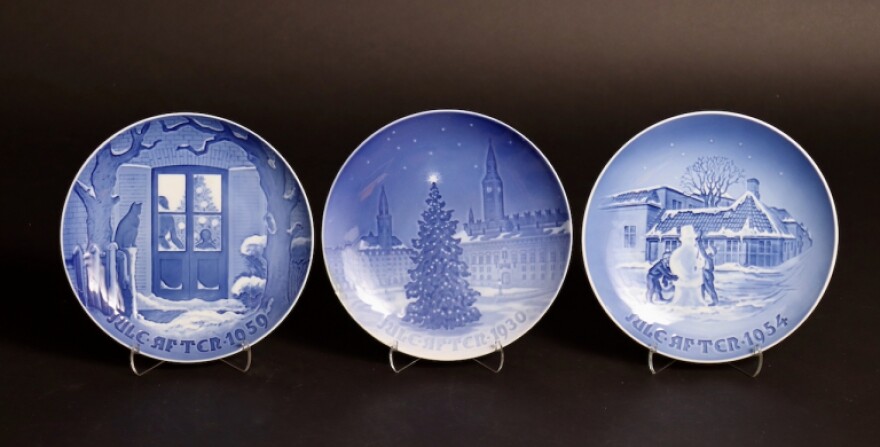Creative industries in Washtenaw County add hundreds of millions of dollars to the local economy. In the weeks and months to come, host Deb Polich, the President and CEO of Creative Washtenaw, explores the myriad of contributors that make up the creative sector in Washtenaw County.

ABOUT MARGARET CARNEY:

Margaret Carney, a ceramic historian who holds a Ph.D. in Asian art history, is founding director of The International Museum of Dinnerware Design, established in Ann Arbor in 2012. She is a fellow of the American Ceramic Society and an elected member of the International Academy of Ceramics. She has curated over 50 exhibitions, authored 80 books, catalogues, and journal articles, and lectured worldwide with an emphasis on ceramic art history.
RESOURCES:
International Museum of Dinnerware Design
International Museum of Dinnerware Design on Facebook
International Museum of Dinnerware Design on Instagram
International Museum of Dinnerware Design Call for Entries
TRANSCRIPTION:
Deb Polich: Welcome to creative:impact on 89 one WEMU. I'm Deb Polich, president and CEO of Creative Washtenaw and your host for creative:impact. Thanks for tuning in on Tuesdays to meet creative guests rooted in Washtenaw County. Each week, we explore how their businesses, products, programs, and services impact and add to our local quality of life, place, and economy. We're going to get the dish on dishes. Margaret Carney is a ceramic historian, and she is the founding director of the International Museum of Dinnerware Design, established in Ann Arbor in 2012. Margaret, welcome and thanks for joining us at the creative:impact table.
Margaret Carney: Thank you so much. I'm really happy to be here.
Deb Polich: You know, with five sets of dishes and glasses to work and coordinate with it, my family thinks I'm a little obsessed with dinnerware. I can't wait to tell them about you, Margaret, and the museum. How did you or your obsession, I mean, collecting and cataloging dinnerware begin?
Margaret Carney: I think I remembered recently that, in 1959, when Elvis Presley was doing Jailhouse Rock, I remember a Christmas where I got a set of play dishes, and they were kind of mid-century colors, primary colors, but, you know, reds and stuff, but colors like the mid-century. And I also got a set of play food, and I think that was it.
Deb Polich: That was not the answer I expected. That's great, Elvis. I love it. You know, so dinnerware is functional for sure. But what makes it an art form?
Margaret Carney: Well, that depends on the designer or the artist. And we collect both dinnerware that was done by the leading designers for industry in the United States, and that would be manufactured ware. And then we also collect individual, one-of-a-kind works of art by individual artists.
Deb Polich: Oh, cool. So, I want to step back for a second. I read that one of the impetus for the museum is the fact that dinners, meals, and the like are really very much about bringing people together and our cultural experiences. How does the museum inform us as visitors or attendees about that?
Margaret Carney: I think our primary way is that we have thematic exhibitions, and each of the exhibitions tells stories. And each object in our collection tells a story, and it is a shared dining experience. And that's why we did create the International Museum of Dinnerware Design.
Deb Polich: And do you actually have a physical collection? And, if so, where is it kept?
Margaret Carney: We do have a physical collection. We have about 9000 objects.
Deb Polich: Oh, my gosh!
Margaret Carney: That seem like a lot. But I know private collectors that have even more. And we have an office and storage space in Ann Arbor. And then, we have three offsite storage spaces.
Deb Polich: Wow! That's a lot of dishware! And where do you do your exhibitions?

Margaret Carney: Well, fortunately, the community has been very welcoming to us, and we've done pop-up exhibitions actually for the entire time since 2012--actually, 2013 was our first. But we're hoping to get our own building to do a fundraising campaign and have our own dedicated museum space.
Deb Polich: Oh, very cool. You know, there's a lot of familiar brands in dinnerware like Wedgwood, Royal, Dalton, Fiestaware, and even Corelle. Are there well-known designers for these brands? I mean, are they individuals?
Margaret Carney: Oh, yes, yes. And that's really what we're all about. We don't want to just have Grandma's little dishes with flowers on them. We want the great designs, which is great shapes. So, people like Eva Zeisel and Ben Seibel and Russell Wright, some of whom are kind of household names, if you like dishes. They designed for major companies.
Deb Polich: And does it include ceramics, china, porcelain, etc.?
Margaret Carney: We have the etc., etc., because we have ceramic glass, metal, paper, plastic, fiber. We collect photographs, advertisements, ashtrays. If it can go on a table top, we collect it.
Deb Polich: So, I'm familiar, because of my work with Artrain, of how, like, the American railroad companies had their own dinner and serveware collections specific to them. Are those kinds of collections in your museum as well?
Margaret Carney: Oh, they certainly are. And, as a matter of fact, we have an exhibition up at the Gifts of Art at the hospital right now, which is called Travel Dining, which includes not only trainware, Pan Am, which is now defunct, some of their dinnerware. And we also have futuristic. We include work that was included in Star Trek: The Next Generation. We go into outer space.

Deb Polich: That's awesome. It gives me excuse to go up to the hospital and look at those great exhibitions. 89 one WEMU's creative:impact continues. I'm your host, Deb Polich, and Margaret Carney, the founder and director of the International Museum of Dinnerware, is my guest. So, we're going to soon be in the thick of the holiday season. And, you know, holiday dinner tables are often the center of all of those family gatherings. What has the role of dinnerware been historically during the holidays?
Margaret Carney: I think it's been kind of all over the place, but most people have at least two sets of china, and one would be their good china, and that would include what they'd get out for the special events, holidays, family gatherings and that kind of thing. And so, last year, we did an exhibition called Holiday Dining, which is still up on our website, dinnerware museum dot org, and they can look at that. But people have a lot of fun and some people like to mix all kinds of dishes together. And I love those people too. They mix handmade dishes by individual artist with manufactured dinnerware. They mix and match, and it's a lot of fun. So, dining doesn't have to be too serious of an event. It can be just a lot of fun.

Deb Polich: Well, that actually brings me to one of my questions. I mean, we all have had great family or gatherings with friends using paper plate and plasticware. How does that fit in?
Margaret Carney: Oh, we collect that. I love paper plates and plasticware. And one of the shows we did a few years ago was called Unapologetic Dinnerware. And it was a brief history of disposable dinnerware.
Deb Polich: Oh cool.

Margaret Carney: Where we brought out--this was at Concordia University, and it's up on our website. It was just one of my favorite shows because it included edible dinnerware and, like, spoons that were edible and cups and gummi shot glasses and then all the different kinds of paper products that if you have a sheep in your backyard, you can put it out for your sheep to eat after you ate.
Deb Polich: Well, that would certainly help with the landfill, wouldn't it?
Margaret Carney: Yes, it would.

Deb Polich: That's great. So, traditionally, you know, I bet you visit historical collections when you travel. I've been to both Buckingham Palace and Holyrude and toured their royal dinnerware collections. And, of course, Downton Abbey surely set a spectacular table, as many of us watched. What about American standouts? What are the American standouts in this field?
Margaret Carney: Well, I think if you're looking for the most beautiful, well-designed dinnerware, it would fall between the 1930s up to maybe the 1970s, but, specifically, mid-century modern dinnerware was set by Eva Zeisel and Russell Wright. They were all the wedding china that everybody bought. And if you think about art deco, the art deco wonderful shapes and colors, those were extremely popular and and eventually successful in the United States and elsewhere.
Deb Polich: So many. There are just so many, and I took a look at your website and you have such, such great images. I encourage people to take a peek. You know, so I understand that you curate lots of shows and do online programming. I saw a call for entry for your fifth biennial juried exhibition on entomophagus dining. Did I say that right?
Margaret Carney: Pretty close. I think it's entomophagus, but maybe's it is how you said it. Actually, we're encouraging artists to get ready for that. We've invited a few people, and then it's a juried show. And there are prizes that Jiffy Mix in Chelsea are providing for us. There's cash prizes. And the show actually opens in April, but the entries are due the end of January this next year. But it's all about eating insects. That's what entomophagus dining is. So, it's what kind of dinnerware would you need? And they say that insects are the protein that's going to feed the world eventually. But what kind of dishes would you use to serve that food? So, it can either be something that because you love butterflies, and you're a vegan or something, or you want to actually have mealworms and ants and anything to do with your dinnerware. What would you need? Or maybe it would just be beautiful. I don't know. But that's what we're going into, so I'm really excited about that.

Deb Polich: Well, we're going to look forward to seeing the show, if not eating the insect. You might want to pass that out or pass up on that. But I think that, you know, it's just so curious. And it's actually something we often take just for granted. Every day, we throw the plates out on the table. We sit down. We eat. We clean them up and put them in the dishwasher or whatnot. And then, we go about it. But it's really central.
Margaret Carney: It is, and it's something that's so varied that everybody has a take on it. So, we don't care what people collect or what they're interested in. We try to do it all. [
Deb Polich: Well, you know, I once had a woman who majored in housekeeping--not housekeeping, but home ec. And she once said that she always sets a pretty table for her family instead of just doing it at the holidays. Because if you love your family, that's something you can do. What do you think of that?
Margaret Carney: Oh, that's a lovely idea. And lots of times, people say they want to maybe donate their dishes to the museum. And I tell people they use them. They think they're so precious. They can't use them. I say use them, enjoy them, create the memories, because that's what dining is all about: creating memories.
Deb Polich: Absolutely. Margaret, thanks for crystallizing our idea of dinnerware and its importance in the creative and culinary worlds. Thanks for being on the show.
Margaret Carney: Thank you.
Deb Polich: That's Margaret Carney, the founding director and curator of the International Museum of Dinnerware Design in Ann Arbor. Find out more about Margaret and the museum at WEMU dot org. You've been listening to creative:impact. I'm Deb Polich, president and CEO of Creative Washtenaw and your creative:impact host. Mat Hopson is our producer. Join us every Tuesday for our conversations with creative Washtenaw guests. Celebrating 45 years of jazz broadcasting, this is 89 one WEMU FM Ypsilanti. Public Radio from Eastern Michigan University.

Non-commercial, fact based reporting is made possible by your financial support. Make your donation to WEMU today to keep your community NPR station thriving.
Like 89.1 WEMU on Facebook and follow us on Twitter
Contact WEMU News at 734.487.3363 or email us at studio@wemu.org







